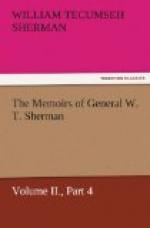On the 20th of July, 1867, President Johnson approved an act to establish peace with certain hostile Indian tribes, the first section of which reads as follows: “Be it enacted, etc., that the President of the United States be and is hereby authorized to appoint a commission to consist of three (3) officers of the army not below the rank of brigadier-general, who, together with N. G. Taylor, Commissioner of Indian Affairs, John B. Henderson, chairman of the Committee of Indian Affairs of the Senate, S. F. Tappan, and John B. Sanborn, shall have power and authority to call together the chiefs and head men of such bands or tribes of Indians as are now waging war against the United States, or committing depredations on the people thereof, to ascertain the alleged reasons for their acts of hostility, and in their discretion, under the direction of the President, to make and conclude with said bands or tribes such treaty stipulations, subject to the action of the Senate, as may remove all just causes of complaint on their part, and at the same time establish security for person and property along the lines of railroad now being constructed to the Pacific and other thoroughfares of travel to the Western Territories, and such as will most likely insure civilization for the Indians, and peace and safety for the whites.”
The President named as the military members Lieutenant-General Sherman, Brigadier-Generals A. H. Terry and W. S. Harney. Subsequently, to insure a full attendance, Brigadier-General C. C. Augur was added to the commission, and his name will be found on most of the treaties. The commissioners met at St. Louis and elected N. G. Taylor, the Commissioner of Indian Affairs, president; J. B. Sanborn, treasurer; and A. S. H. White, Esq., of Washington, D. C., secretary. The year 1867 was too far advanced to complete the task assigned during that season, and it was agreed that a steamboat (St. John’s) should be chartered to convey the commission up the Missouri River, and we adjourned to meet at Omaha. In the St. John’s the commission proceeded up the Missouri River, holding informal “talks” with the Santees at their agency near the Niobrara, the Yanktonnais at Fort Thompson, and the Ogallallas, Minneconjous, Sans Arcs, etc., at Fort Sully. From this point runners were sent out to the Sioux occupying the country west of the Missouri River, to meet us in council at the Forks of the Platte that fall, and to Sitting Bull’s band of outlaw Sioux, and the Crows on the upper Yellowstone, to meet us in May, 1868, at Fort Laramie. We proceeded up the river to the mouth of the Cheyenne and turned back to Omaha, having ample time on this steamboat to discuss and deliberate on the problems submitted to our charge.




